Day 1 of a three day long weekend of tours today. It was a lovely warm, sunny day – a nice day to be out on the North Norfolk coast.
With a big high tide this morning, we stopped at Stiffkey Fen first on our way past to see if any waders had come in to roost. As we got out of the minibus, a couple of Swallows were hawking for insects low over the field nest door and a Yellowhammer was singing somewhere in the trees. Across the road, there were lots of butterflies in the grass, Meadow Browns and Ringlets. The path is getting rather overgrown now, but as we walked down between the hedges, a Banded Demoiselle flitted ahead of us.

As we got into the small copse of trees, a couple of Bullfinches flew up from the path calling. We could just see them on a branch over the path before they flew off further into the wood. We could hear a flock of tits calling down by the road – Blue Tits and Coal Tits – and a Jay in the trees.
Several House Martins were swooping in and out of the eaves of the house on the hill when we got out into the open again. There were more tits down by the river, and a Chiffchaff with them. When we got to the point where the brambles are lower, we could just see out over the Fen. We could see a group of Spoonbills and lots of roosting waders, including a small party of Greenshank on the islands, but it was hard to see over the vegetation now that it is getting taller.
There was a better view of the Fen from the seawall. The Spoonbills were doing what Spoonbills like to do best – sleeping! They like to roost over high tide and feed out on the saltmarsh when the tide goes out. We counted sixteen of them, and occasionally one or two would wake up and show us their distinctive bills. There were quite a few juveniles with them – as birds disperse from the breeding colony at Holkham, the adults creche the youngsters on pools closer to their favoured feeding areas.
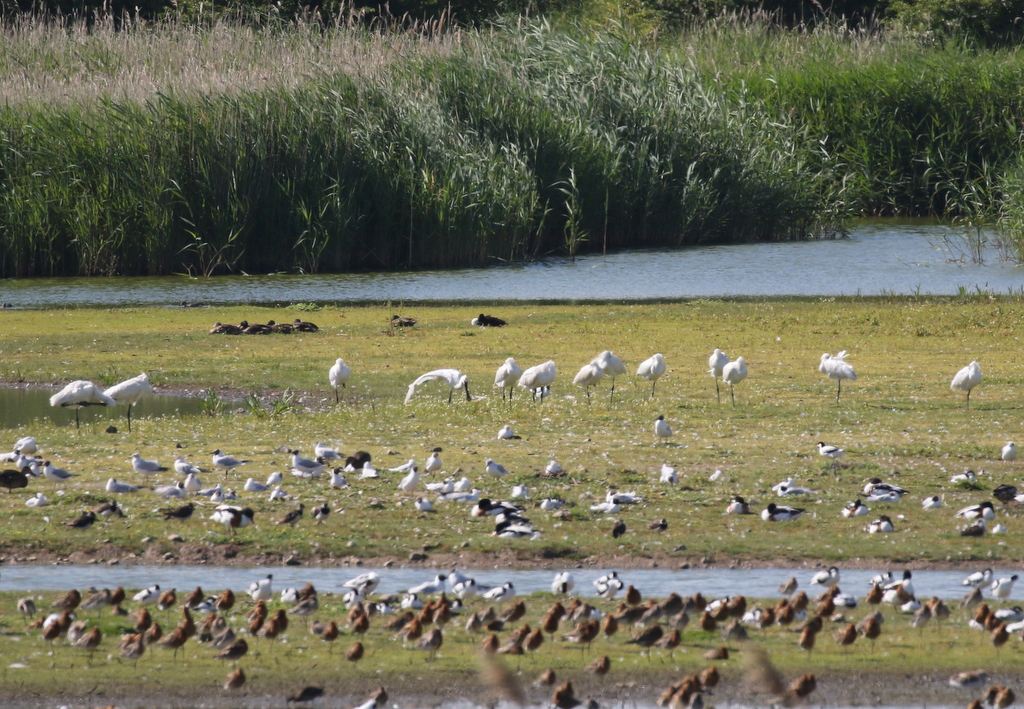
We had a better view of the waders up here too. There were ten Greenshanks roosting together in a group on their own further back. Most of the waders were Black-tailed Godwits, many still in rusty breeding plumage, with several Redshank in with them. A single Ruff was in with the Lapwings and Avocets in the middle. We eventually managed to find two Little Ringed Plovers which were hiding in the taller vegetation at the back of the island, though it was not a great view of them!
Most of the gulls on the Fen are Black-headed Gulls, but we could see a couple of Common Gulls and a Lesser Black-backed Gull too. There were plenty of Greylag Geese and a single Egyptian Goose with two small goslings.
A male Marsh Harrier flew in from the fields beyond, spooking many of the birds and temporarily even waking the Spoonbills. Two juvenile Marsh Harriers came up to meet it, hoping to be fed. We could see they were very dark, chocolate brown with tawny orange heads.
A Common Whitethroat was singing from the top of a bush a bit further down along the coastal path and a Cetti’s Warbler shouted intermittently from the sallows on the edge of the reeds. A Reed Bunting was singing its rather limited song out on the saltmarsh across the channel.
The tide was in out in the harbour. We could see the seals pulled out on Blakeney Point over the other side of the water. A Common Tern was patrolling up and down the channel, fishing, periodically twisting and plunging down into the water. A male Marsh Harrier quartered over the saltmarsh – the light was perfect and it was great to watch it.

As we walked back, a Lesser Whitethroat flew across and landed briefly in the top of one of the sallows by the path. A flock of Long-tailed Tits was in the willows closer to the road, along with a female Blackcap. There were several nice, fresh Gatekeepers in the brambles and hedges this morning, with the first ones having just emerged in the last few days. One posed nicely for us on the hedge by the path.
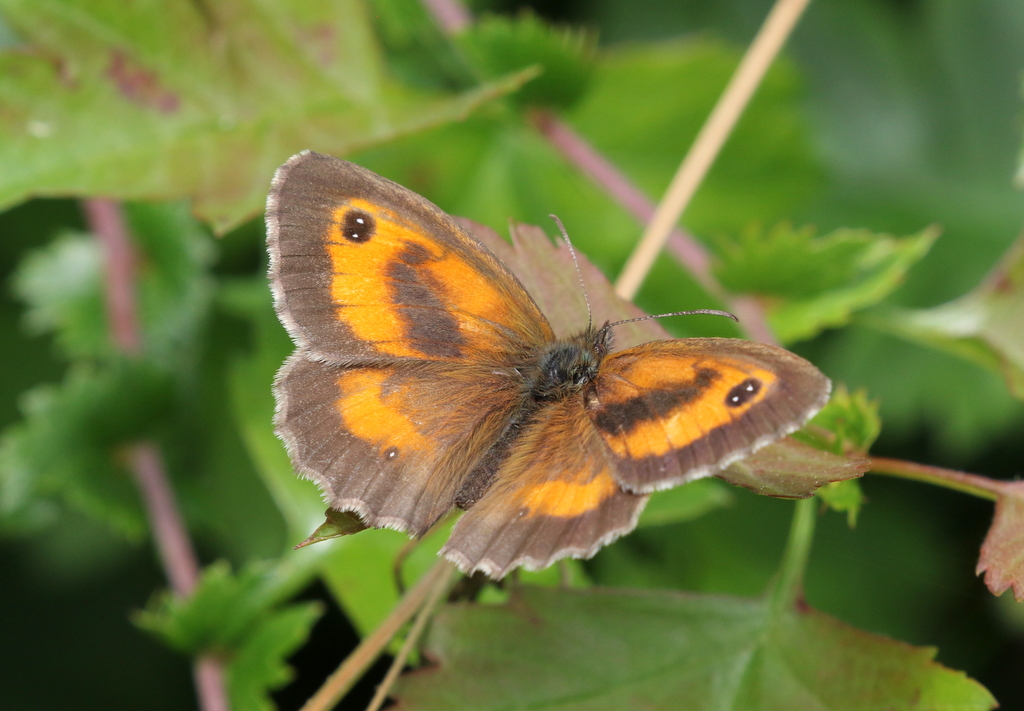
We made our way over to Kelling Heath next. As we got out of the minibus, a Garden Warbler was singing in the blackthorn, but it went quiet as we walked over to look for it. There were lots of butterflies out here too, as we made our way up the path – a Comma, a nice fresh Painted Lady, and several Small Skippers. We managed to get a view of the underside of their antennae, to confirm their ID – pale in Small Skipper and black in the very similar Essex Skipper.
When we got to an area of low-cut heather by the path, we found plenty of Silver-studded Blues still on the wing. Some of them are looking a bit faded and tatty now , but a smart blue male posed nicely for us.

We made our way round through an area where there have been Dartford Warblers in the past. We haven’t seen one in this territory this year, so we weren’t expecting to find one here today but suddenly we heard one singing behind us. We could see it climbing around in a small birch tree growing out of some tall gorse, but it flew quickly and dropped down out of view. It continued singing on and off then flew across the path and dropped down into the gorse the other side. We hoped it might perch up singing for us, but it disappeared back and we didn’t hear it again.
Continuing on across the heath, we flushed a couple of Yellowhammers from the grass. A little further on we found one of them again, feeding on a stony path, collecting insects. It had quite a bill-full already – presumably it had hungry young to feed somewhere nearby.
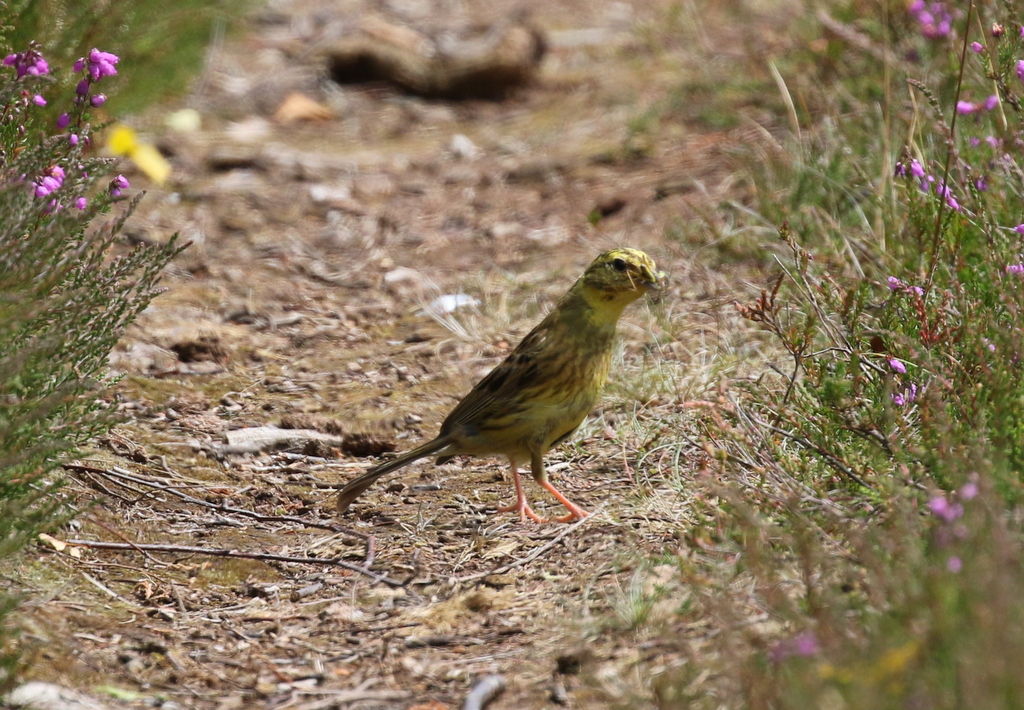
The next couple of areas we checked out were quite quiet now, so we walked over to where one of the pairs of Stonechats have bred. We quickly found the pair – the male and female flycatching from the tops of the bushes, with the young mostly hiding in the vegetation below but popping up occasionally. We stopped to watch a family of Linnets, flying around and perching obligingly on the top of the gorse bushes. We heard a Willow Warbler calling and looked over to see it perched nearby. Unusually it remained still long enough for us even to get it in the scope.
A dark shape flicked out of the gorse and we looked over to see another Dartford Warbler flying low across, skimming the top of the heath. It dropped down into another gorse bush and seemed to have disappeared, but just as we were about to give up it flew out again. This time it flew into a large dense gorse clump and went quiet.
It was time for lunch, so we made our way back to the car park and drove down to the Visitor Centre at Cley to make use of the picnic tables. The main car park was roped off, so we had to park in the overflow car park. From the picnic area we could see why – a Little Ringed Plover had chosen to nest in the middle of the car park! It was very well camouflaged against the gravel and hard to see until you knew where it was, or it got up and walked around.
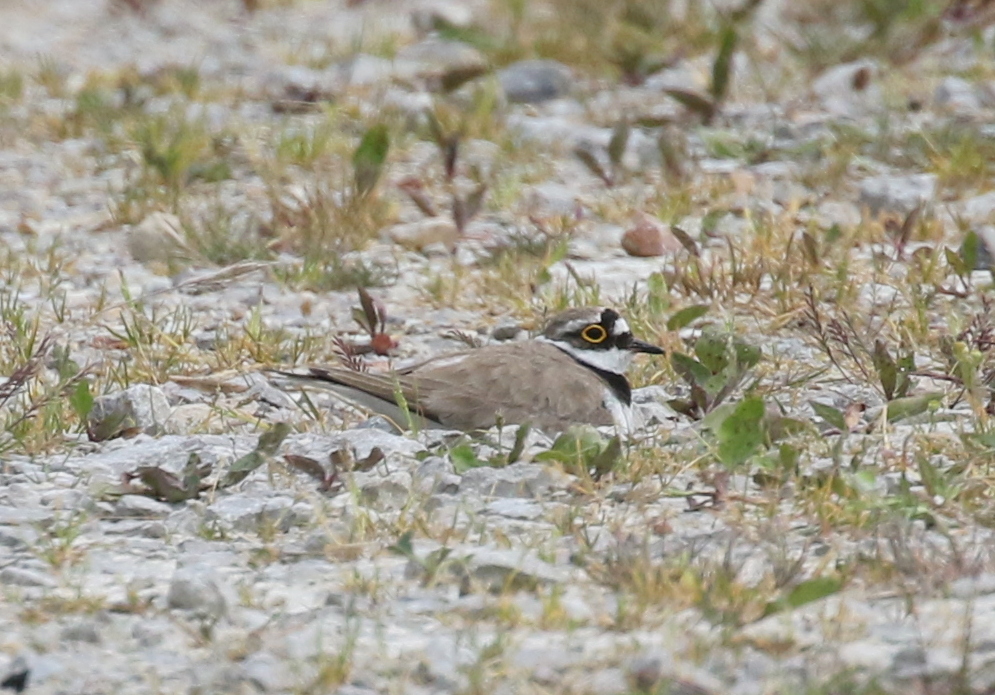
As we ate our lunch, a flock of House Martins came in too and started landing on the now vacant car park. Two Common Buzzards circled over. Looking out over the reserve, something spooked everything out on the scrapes. Lots of waders flew round calling and nine Spoonbills came up and circled over. Some of them dropped down again, but several flew off.
After lunch, we made our way out onto the reserve. A Reed Warbler was singing from the ditch by the path, but remained well hidden. Then from the bridge a little further along, we found two more Reed Warblers feeding in the reeds, and one of them showed very well, picking insects from the sparse reed stems out in the middle of the water.
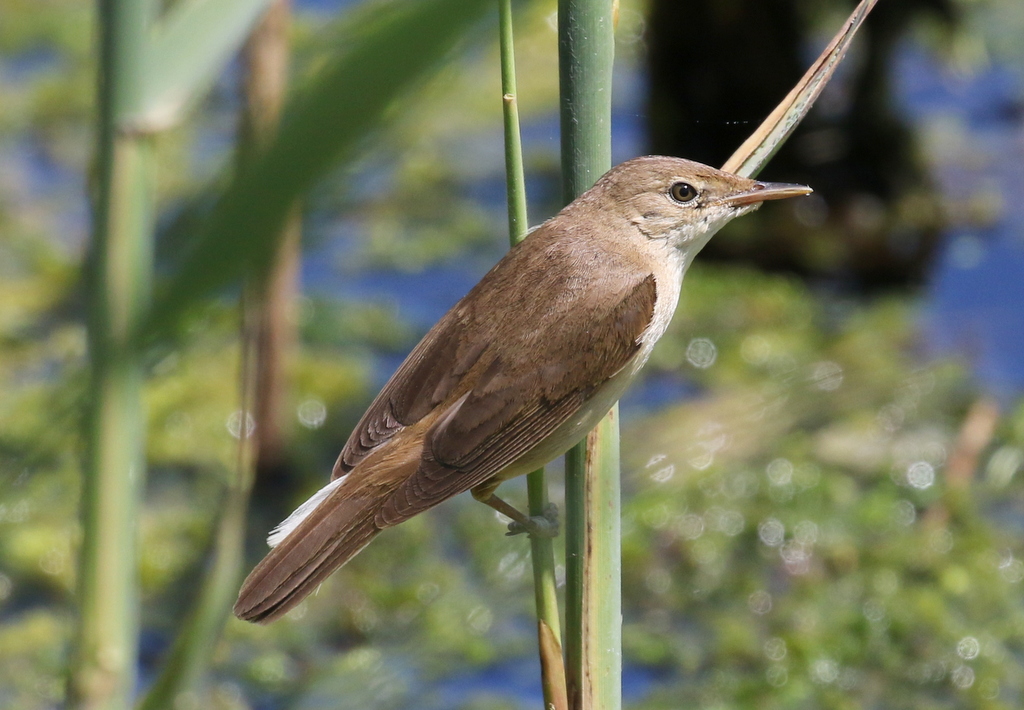
Out at Dauke’s Hide, there were still three Spoonbills, and they too were asleep, on one of the islands. There were lots of waders – Avocets, Black-tailed Godwits, eight Knot and a few Dunlin still in breeding plumage and sporting their black belly patches. No two of the several Ruff were alike, the males are so variable. Most had already lost their ornate ruffs, looking rather scrawny-necked. A pale, leucistic Little Ringed Plover was running around on the edge of one of the islands at the back.
Looking round from the side of the hide at Whitwell Scrape, we could see a Green Sandpiper hiding in the low reeds on the edge of the island towards the back. An Avocet is nesting on the island at the front and we watched it settle down on to brood its four eggs.
There were plenty of Teal on the scrapes, but there had been no report today of the Green-winged Teal which has been here for a couple of weeks now. Looking carefully through the ducks, we managed to find it and we could see why it had not been spotted earlier. It is moulting fast into eclipse plumage, and we could just see the remains of the white foreflank stripe which distinguishes Green-winged Teal from the other regular Eurasian Teal. It was now reduced to just a white spot on the side of the breast and you had to look very carefully to see it. It won’t be long before it, and therefore the bird itself, disappears completely!
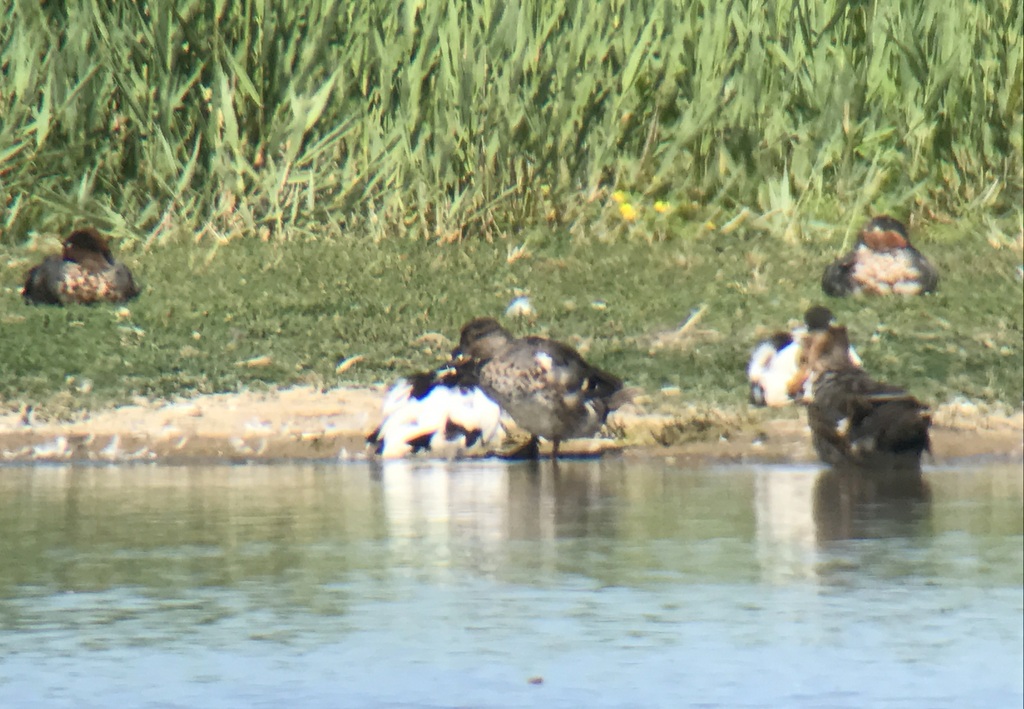
A Marsh Harrier flew high over the scrape and everything flushed, at which point we lost sight of the Green-winged Teal. We took that as a cue to move on, round to Teal Hide. There were much the same waders on Pat’s Pool as we had seen on Simmond’s Scrape. There were several more Ruff, one of which was still sporting the remains of its ornate ruff. Three more Little Ringed Plovers were well camouflaged on the mud on the edge of the island. Two half-grown juvenile Redshanks were on the near edge of the water.
Scanning the reeds at the back of the scrape, we picked up a juvenile Bearded Tit working its way along the water’s edge. There had been a Water Rail on the mud at the back earlier, but we couldn’t find it, although we did hear it squealing. We were just about to leave when someone spotted it again. We got it in the scopes and watched it creeping in and out of the base of the reeds.
We drove round to Walsey Hills next. Several Coot were out on Snipe’s Marsh and a single Little Grebe was diving in front of the reeds. Several Common Pochard included a female still with three small ducklings. We watched the ducklings diving, leaping up in the air to get themselves down into the water. Across the road, we could see lots of damselflies flying low over the water in the ditch. They included several Small Red-eyed Damselflies, including a pair which we watched ovipositing.
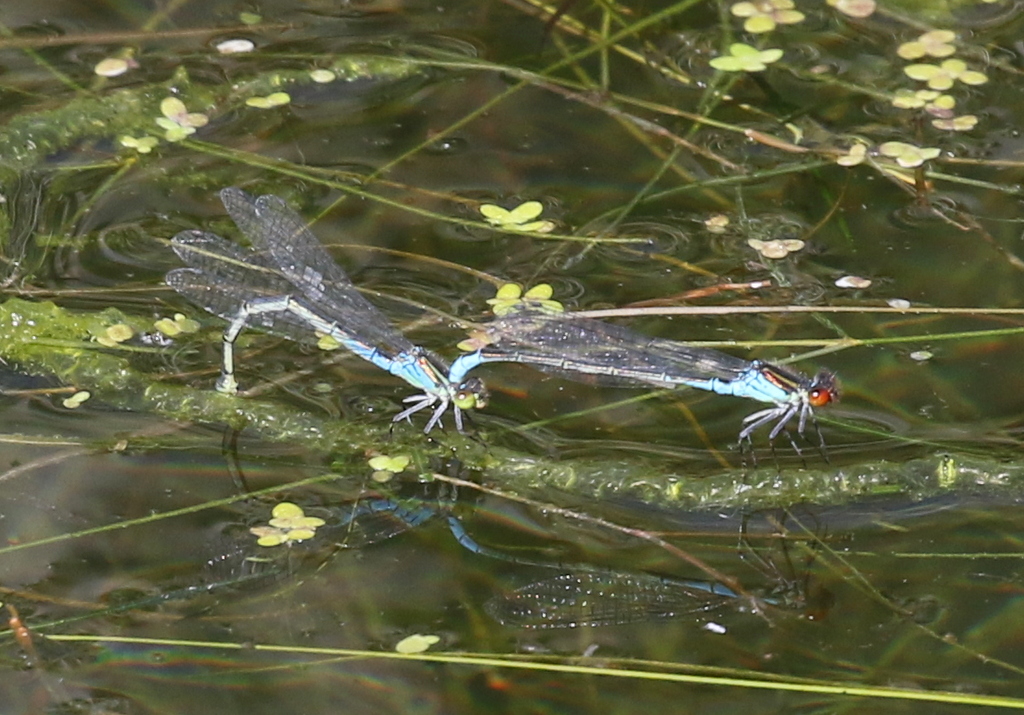
Walking out along the East Bank, several Reed Warblers were flitting around the edge of Don’s Pool. We heard Bearded Tit calling but couldn’t see it. A large flock of Sand Martins were flying round over the bank further up and when we got over there we could see they were landing in the tops of the reeds on the edge of the dicth. We couldn’t see what they were feeding on though. They flew off as some people walked past, and then started settling out on the dried mud by the Serpentine.

Several Cormorants were drying their wings on the island out on Pope’s Pool. In front, we could see lots of Curlew in the grass. They are returning in numbers from their breeding grounds on the continent now. We heard Whimbrel calling and looked up to see three flying over, followed shortly after by one of the Curlews for comparison. We could see the Whimbrel were noticeably smaller and slimmer, with a shorter bill. A single Little Ringed Plover was on the mud by the Serpentine.
As we got to Arnold’s Marsh, we had a quick scan and spotted a Little Gull swimming out on the water. At one point it was in the same scope view as a Black-headed Gull giving a chance to see just how small it was by comparison. Then when we took our eyes off it, it disappeared, presumably back to the scrapes where it had been seen earlier. Several young Great Black-backed Gulls were loafing in the vegetation at the back. There were a few waders on here too – Black-tailed Godwits, Redshank and a few Curlew. A Brown Hare ran across the dry mud just beyond the water.
There were several Meadow Pipits on the path, flying up to catch insects from the overhanging vegetation. One started displaying behind us, and as it parachuted down it suddenly changed from singing to alarm calling as it hovered over the grass. A Weasel ran out and across the path.
Walking on to the beach, a Ringed Plover over calling. As we got to the shingle, another Whimbrel flew in off the sea. They were clearly on the move today, freshly arrived back from the continent on their way south. A few Sandwich Terns were passing offshore.
We were tipped off by a local about some Graylings a short way down along the old shingle ridge, so we walked down to look for them. They were very hard to see unless you flushed them, very camouflaged against stones, but we eventually found two when they flew up and settled again. A very localised butterfly, they are always nice to see when they are on the wing and these were the first we have seen this year.

It was lovely out at the beach this afternoon, in the sunshine, but we were out of time and we had to head back. As we got to the East Bank, four Spoonbills flew overhead and dropped down towards the reserve. We stopped to look at a skipper in the grass on the edge of the path and this one had distinctive black tips to the underside of its antennae – an Essex Skipper this time. A nice last addition to the butterfly list as we headed for home.
















